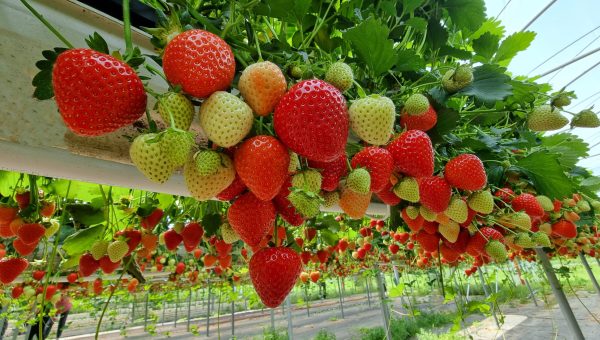The Biology of Soil Fertility:
Soil fertility is an essential factor that directly influences agricultural productivity and the sustainability of terrestrial ecosystems. Understanding the elements that contribute to this fertility, such as mineral composition, organic matter, soil structure and biological activity, is fundamental to implement management practices that promote its conservation and improvement.
In this blog, we will explore in depth the components and processes that determine soil fertility, providing valuable information for farmers, researchers and anyone interested in soil health and sustainable food production.
1. What is soil?
Soil is the natural environment that is composed of solid materials (including minerals and organic matter), liquids and gases and is the habitat of all kinds of living things: lichens, mosses, plants, microorganisms and also other larger animals.
The definition of soil according to Soil Survey Staff, 1999; is linked to one or both of the following characteristics: “It presents horizons or layers that originated from an initial material as a result of transformations, loss, additions and transfers of energy and matter or by the capacity to support plants in the natural environment”.
The traditional definition of soil specifies that soil is the natural medium for the development of terrestrial plants, whether or not it has discernible horizons (Keys to Soil Taxonomy, ed 2014). However, it should not be forgotten that it is a biologically active porous medium, since it contains not only inorganic matter, but also elements such as humus and living beings.
EDAFOLOGY
… is the scientific discipline that studies, evaluates, compares and determines the composition, structure and dynamics of soils, considering both their origin and their evolution over time.
Through the analysis of its physical, chemical and biological properties, soil science provides an understanding of the fundamental role played by soil in ecosystems and agricultural production.
This discipline is closely related to other sciences, such as geology, hydrology and ecology.

2. What forms the soil?
Soil is a complex natural resource that forms over thousands or even millions of years, the result of the interaction of various factors such as climate, living organisms, parent material, relief and time. This process, known as pedogenesis, transforms rocks and minerals into a dynamic system composed of solid particles, water, air and organic matter.
Each of these elements contributes to the structure, composition and fertility of soil, making it an essential component for the development of terrestrial ecosystems, agricultural production and the regulation of biogeochemical cycles. Understanding how soil is formed allows us to appreciate its importance and manage its use in a sustainable manner.
Its components include:
Mineralswhich depend mainly on the characteristics of the source rock. Among them are: phosphorus, potassium, calcium and magnesium.
Organic matter. Originating from the decomposition of dead plants and animals. Organic matter and humus store many soil nutrients. Vegetation, climate, soil texture, drainage and tillage will determine the amount of organic material present in a soil.
Water and air. Estos elementos ocupan los poros del suelo, que son aquellos espacios entre las partículas y que dependen de la forma y tamaño de estas. The quantity and size of these components largely determine the presence of microorganisms and organisms linked to that soil. In addition, the combination of these factors will determine how easily the plants will take up water, as well as aeration and mineral uptake.
Microorganisms. T They play a very important role in this environment, since they not only use organic matter, but also perform functions such as decomposition of nutrients, contribute to the reuse of organic matter, promote aeration and water storage. There are also other organisms such as nematodes.

Soil erosion is an environmental problem associated with the indiscriminate use of chemicals in agriculture.

3. Soil Horizons: Classification Systems.
The identification and designation of horizons is one of the essential processes in the study and classification of soils.
These horizons, which represent layers with unique physical, chemical and biological characteristics, are key to understanding the formation, evolution and functioning of soils. To describe and differentiate them, a nomenclature system combining letters and numbers is used, allowing an accurate and universal representation of their particularities.
Horizons can be classified into two general groups: Genetic horizons and Diagnostic horizons.

Soil genetic horizons.
Genetic horizons reflect the natural processes that led to their development over time. These processes include the accumulation of organic matter at the surface, the leaching of nutrients and minerals into deeper layers, the chemical and physical weathering of soil particles, and the transformation of primary minerals into secondary compounds.
Through these horizons the complete soil profile is described, providing information about its history and the environmental conditions that affected it. Unlike diagnostic horizons, which are used for more standardized and technical classifications, genetic horizons are interpretative and can be somewhat more subjective, since they depend on the observation and analysis of the soil profile.
For this reason, the terms “horizons” or “layers” are often used interchangeably to refer to them, highlighting their descriptive nature and their ability to reveal the dynamic processes that shape the soil.
Horizon O: Su main component is decomposed organic matter. In some cases they can be saturated with water.
Horizon A: It may still pt may still contain organic matter in its compositionin it herbaceous vegetation takes root in it.. Es un horizonte que se localiza en la superficie o bajo el horizonte O. Soils that have undergone anthropogenic transformation are called Horizon A.
Horizon L: Predominantly organic and inorganic materials from the precipitation of the upper layer.
In this layer, the action of aquatic organisms such as algae, diatoms or aquatic plants is important.
Horizon B: Also known as precipitate zone, it follows that its composition depends on the upper horizon.
It has a lighter color due to a lower proportion of humus. Some of the elements that can presentsr are clayey materials, metallic oxides and hydroxides, etc.
Horizons C: A layer little affected by soil formation processes (pedogenesis, edaphogenesis). Its composition is mainly of mineral origin.
Horizon R: This is the consolidated bedrock.
Soil Diagnostic Horizons.
Epipedons are located in the upper part of the soil profile and usually contain organic matter and essential nutrients, while Endopedons, located in deeper layers, reflect processes such as the accumulation of clays, salts, oxides or carbonates, playing a crucial role in the evaluation of the soil’s capacity to support different uses and functions.
Endopedons
Subsurface horizons
Associated with agricultural activity. Contains silt, clay and humus.
Formed by eluviation. It has a whitish color y meterials albic.
It is characterized by the accumulation of silicate clays silicate claysas a result of illuviation.
Its composition is dominated by calcium carbonate and/or other carbonates.calcium carbonate and/or other carbonates.
Sandy texture. Thickness between 15 and 25 cm. Content, generally, low in carbonates (since this will be found in the underlying horizon). the calcium horizon).
Its content depends on the physicochemical physicochemical alterations that occur in an argillic horizon argillic horizon, kandic o natric horizon.
It has secondary gypsum in its composition. It may accumulate uniformly or in gravels or cobbles.
Continuation to a coarser textured horizon.
It presents a significant amount of sodium. It is a type of argillic horizon.
Contains materials from the horizon spodic, with a cemented layer.
Cemented and hardened appearance, with accumulations of secondary calcium carbonate and other carbonates.
Cemented or hardened. Minimum thickness of 10 cm.
In its composition may contain iron and/or manganese, as well as organic matter.
Accumulation of salts that are more soluble than gypsum.
It depends on the free drainage of mineral soils. It is not very common in the Iberian Peninsula.
It presents materials with a high pH load, as well as a high retention of water and pH, as well as a high retention of water and illuvial substances. illuvial substances organic matter and Al, with or without Fe.
Epipediones
Surface horizons
Superficial. Mainly organic matter. Water saturated, less than 30 days.
It is saturatedo water saturated for more than 30 days or drained.o artificially.
Dark color due to the high content of organic matter from the decomposition of grass roots.
Dark, medium-high composition of organic material and high base saturation and high saturation with bases.
It is usually thin, dry and low in organic carbon. content.
Tt has similarities with the Mollic, but in this case, the percentage of saturation with basic compounds is higher than 50%.
Originated by human activity. It usually presents similarities with the epipedion mollic.
Layer surface with anthropogenic origin. Thickness greater than 50 cm. May co nhave, straw, bricks, ceramics, etc.

4. Tipos de suelos: Taxonomía de suelos del USDA.
The USDA soil classification was first published in 1975. This system follows a hierarchical order in which soil types are grouped into twelve categories.
Although the main purpose of this document was to have a taxonomic record of U.S. soils, it is now considered a worldwide reference system for classifying all soils of the world.

This type of soil is usually associated with deciduous forests, and can be found in temperate and cold regions as well as in subtropical and tropical regions.. Estos suelos están destinados a actividades agrícolas, de pastoreo y forestales. Se caracterizan por la presencia de nutrientes importantes en el horizonte C, lo cual se asocia a la capacidad de fertilidad del suelo. A veces se ha visto problemas de fijación de potasio y amono asociados a cantidades de arcilla illitic in this type of soils.
They are formed on volcanic materials. They are located in Japan, Indonesia, Australia, South America, New Zealand, Central America, etc.
In its composition, the amount of alumunic complexes alumunic complexes-humic complexes, allophane, imogolite o ferrihydrite. Son suelos con mucho glass volcanic glass, with high phosphate retention capacity.
Available water is limited, which affects the existing vegetation. The surface is generally bare and gravelly. Agricultural use is limited by the The use of irrigation could solve this problem, although with irrigation it could bethis problem. Regarding your content, low levels of nitrogen (due to the low organic matter content).
Little or no evidence of pedogenetic horizons pedogeneticThis is generally due to lack of time for its development or to the presence of steep slopes where erosion is predominant. An important feature of this type of soil is its mineral nature.
One of the most notorious characteristics of these soils is the presence of a surface layer called permafrost.The presence of a superficial layer called permafrost is one of the most notorious characteristics of these soils, which remains at temperatures temperatures below 0ºC for more than two consecutive years.
Soils with a large amount of organic matter (more than 50% of its volume), such as swamps, bogs, peat bogs, etc. Total or partial water saturation is common during most of the year. Given this the associated vegetation is made up of aquatic or tolerant plants. or plants tolerant to excess water.
They can be soils used for cultivation, but they must be previously drained.although this in many cases is associated with oxidation and settling. settlement and settling of the soil. This type of soil is useful for the production of vegetables such as onions, potatoes, carrots, etc.
They are poorly altered soils whose features closely resemble the nature of the original bedrock.
Their location is varied, ranging from equatorial regions to tundra. In this type of soils the drainage is very variable. , even even so, the poorly drained ones can be used for cultivation once drained.
These soils are rich in organic matter y, therefore, they present dark tones. They can be found in North America, Europe, Asia and Asiatic countries. South America. They are associated with agricultural practices, specifically for the cultivation of cereals and soybeans.
Yellow and reddish tones predominate. They are located in tropical and subtropical regions. . Se desarrollan sobre superficies muy estables que presentan alteración en capas profundas, aunque hay diferencias significativas en base a esta profundidad.
They have a high resistance to erosion when they are cultivated and are cultivated and relatively fast permeability. Although they present some favorable characteristics for agricultural practice, most of them are soils that are considered to be of low fertility.jt productivity for crops, but with the use of modern techniques, fertilizers, pesticides, etc., the soil has a high resistance to erosion when cultivated and a relatively fast permeability, etc. can give good results.
Most of them present a horizon where there is a mixture of organic matter and aluminum and iron oxides that have accumulated by by illuviation.this is the spodic horizon spodic. Son suelos acids and poor in silicate clays silicate clays found in cold, humid, warm intertropical and humid climates. humid climates. The associated vegetation is conifers, in general, with organic matter. organic matter of slow decomposition. The Spodosols are related to agricultural, livestock and forestry practices.
A reddish coloration predominates. Most of the bases released by the movement of water are retained by the vegetation or accumulate in the most superficial layers of the soil. These soils are associated with coniferous or broadleaf forest vegetation and a warm-humid climate where there are seasons that mark changes in precipitation.
They are generally soils with a high degree of alteration and evolution, they are good for agriculture, but only during the first years (when they present the greatest amount of nutrient reserves), after these first years the use of manures or fertilizers is recommended. Ultisols have a strong dependence on coniferous and broadleaf vegetation, since they maintain the fertility of the first layers by extracting nutrients from deeper layers with their roots.
These are clayey soils, which may present stains and cracks. Morphologically variable in terms of color (there are both dark and pale), as well as moisture and base saturation. . La mayoría están asociados a un régimen térmico and are important in the agricultural use of soils, since their surface layer (mulch) determines whether planting will be more be more or less or less difficult to prepare.






